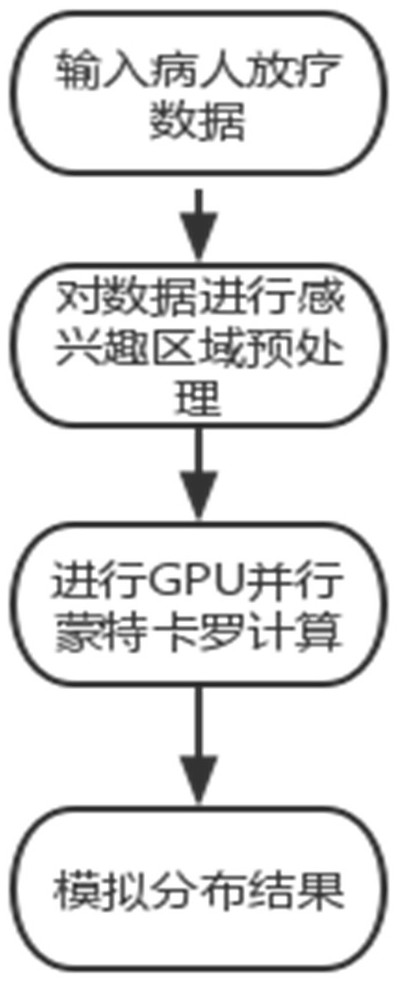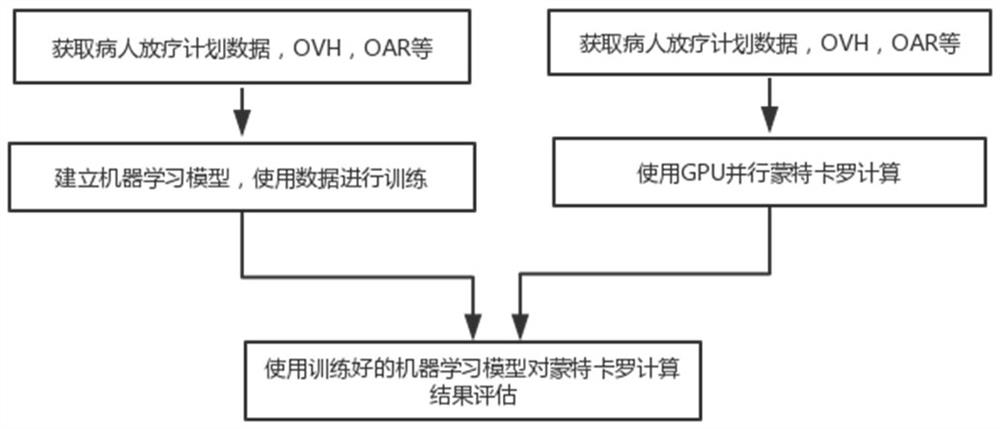Radiotherapy dose calculation and verification method based on machine learning and Monte Carlo algorithm
A Monte Carlo algorithm and machine learning technology, applied in mechanical/radiation/invasive therapy, nuclear methods, computer-aided medical procedures, etc., can solve the problem that takes a long time, consumes a lot of time, and cannot detect clinical significance Implement errors and other issues to achieve the effects of improving efficiency, accelerating calculation speed, and facilitating the evaluation of overall accuracy
- Summary
- Abstract
- Description
- Claims
- Application Information
AI Technical Summary
Problems solved by technology
Method used
Image
Examples
Embodiment 1
[0033]A GPU-based parallel Monte Carlo dose calculation method, such asfigure 1 As shown, it is suitable for execution in a computing device and includes the following steps:
[0034](1) Data input: input the patient's CT image, target area organs and organs at risk outline image and DVH image, material density, material information, source parameters, geometric information of the phantom, etc.;
[0035](2) Particle input simulation: use the CUDA framework of NVIDIA Corporation, use the GPU of the graphics card for parallel calculation, and use the Monte Carlo particle transportation principle for particle transportation to obtain the simulated dose distribution;
[0036](3) Output step (2) The simulation result obtained by Monte Carlo based on parallel GPU.
[0037](4) Use parameters to establish a machine learning model. Verify the output of step (3)
Embodiment 2
[0039]A GPU-based parallel computing method, including the following steps:
[0040](41) Before the simulation starts. It is necessary to first apply for enough storage space for each computing unit, that is, each thread to record the data in the transportation process and the final deposition result. Monte Carlo simulation is inherently random and cannot predict which path a given particle will take, so it is impossible to recombine particles with the same fate into the same warpage. When warpage is divergent, it is divergent
[0041](42) Due to the need of parallel computing, all the original photons participating in the transportation are divided into several groups with the same number. Each group of photons is handed over to an arithmetic matrix composed of one or several arithmetic units (usually 32 or 16). The dose accumulation during the transportation of the same group of photons is added to a shared storage matrix representing the distribution of voxels Then the data is returned...
Embodiment 3
[0045]The present invention also provides a computing device, including:
[0046]One or more GPU processors; a memory; and one or more programs, wherein the one or more programs are stored in the memory and configured to be executed by one or more GPU processors, the one or Multiple programs include instructions for the Monte Carlo dose calculation method, which includes the steps:
[0047]A Monte Carlo dose calculation method, suitable for execution in a calculation device, includes the following steps:
[0048](1) Data input: input the patient's CT image, target area organs and organs at risk outline image and DVH image, material density, material information, source parameters, geometric information of the phantom, etc.;
[0049](2) Particle input simulation: use the CUDA framework of NVIDIA Corporation, use the GPU of the graphics card for parallel calculation, and use the Monte Carlo particle transportation principle for particle transportation to obtain the simulated dose distribution;
[00...
PUM
 Login to View More
Login to View More Abstract
Description
Claims
Application Information
 Login to View More
Login to View More - R&D
- Intellectual Property
- Life Sciences
- Materials
- Tech Scout
- Unparalleled Data Quality
- Higher Quality Content
- 60% Fewer Hallucinations
Browse by: Latest US Patents, China's latest patents, Technical Efficacy Thesaurus, Application Domain, Technology Topic, Popular Technical Reports.
© 2025 PatSnap. All rights reserved.Legal|Privacy policy|Modern Slavery Act Transparency Statement|Sitemap|About US| Contact US: help@patsnap.com



